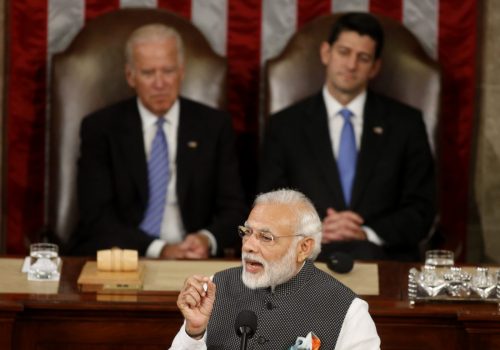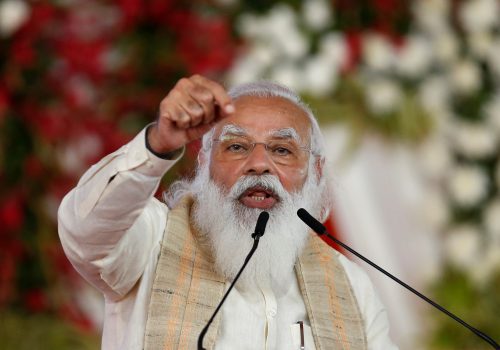India’s digital policies are putting US tech in a bind
India has a message for US tech firms: Play by our rules—or risk losing out on our 750 million internet users.
While India’s size and growth potential make it an attractive target for investment, these same factors also give Prime Minister Narendra Modi’s government unique leverage over America’s largest tech platforms. What’s more, India has increasingly used this leverage to extract its pound of flesh from US tech firms.
In 2018, for example, it forced global payments companies to store data locally, even though the policy imperatives were questionable and the move created new tensions in the country’s trade relationship with Washington. A year later, the Indian government abruptly changed investment rules for foreign e-commerce platforms that had invested billions in the market but not for their domestic peers. Then, in 2020, authorities unveiled a new digital tax on foreign internet platforms and online businesses, once again provoking the ire of US trade officials. And just this year, New Delhi laid out controversial new rules to regulate global messaging, streaming, and online-news platforms and to criminalize non-compliance. That triggered a new showdown between social-media giants and Indian authorities, which could potentially pull in US trade officials.
India isn’t alone in reining in US tech companies and promoting homegrown alternatives. But policymakers in New Delhi are increasingly willing to flex their muscles and go much further after calculating that tech platforms need India more than India needs them.
So far, that bet is paying off: US tech executives have reluctantly accepted most of these policy changes while continuing to invest billions in the Indian market. The promise of a market with 1.3 billion potential users remains too alluring to abandon.
Still, concerns are growing as the Modi government continues its quest to bring US and other foreign firms to heel. The recent police raid on Twitter’s local office was just the latest episode in a drama that’s elevated these worries to the C-suite level. Today, analysts even wonder whether India will follow China in walling off its digital economy to foreign players. They point to the government’s slogan of “self-reliance” and its vocal political support for homegrown enterprises as warning signs regarding New Delhi’s intentions.
The reality is more subtle. Although India holds significant leverage over US tech platforms, New Delhi also knows that expelling them would erase a source of economic and diplomatic strength for the country. Ousting American tech firms would also damage relations with the United States and deprive Indians of digital services that they have come to rely on, especially in the COVID-19 era. The US government has been increasingly explicit in its threats of retaliation—most recently pursuing a review of India’s digital tax that includes the possibility of raising tariffs on India’s exports.
That’s why India is unlikely to duplicate the Chinese playbook. Nor, however, will it let US tech companies rest easy: The vision of a self-reliant Digital India remains compelling in Delhi. Barring a sudden shift in the government’s outlook, digital sovereignty will remain a central pillar of Indian tech policy.
Key considerations for US tech firms
Against this backdrop, and especially given that the digital-services trade is likely to be the highest-valued US export for years to come, US industry should keep three considerations in mind.
First is the question of what will rise faster: India’s netizens and their purchasing power, or the policy barriers gating access to the country’s digital economy? The gap between the two will define the real opportunity for US firms and should shape the pace of their investment.
Second, companies will need to clearly define the red lines that would trigger reduced investment or a reallocation of resources to other emerging markets. Just as important, executives must be prepared to respond when those red lines are crossed. Simply crying foul without imposing economic costs on New Delhi undermines US tech firms’ credibility as well as their bargaining power.
Third, companies need to think strategically about their asks of US officials focused on maintaining strong trade and diplomatic ties with allies and partners. The Biden administration has clearly signaled its desire to cement strategic ties with India, including in the technology sphere, but it has also shown willingness to maintain trade pressure on India and other countries erecting barriers to digital trade. There are already warning signs of new trade tensions to come, even if the Biden administration is less inclined than the Trump administration to retaliate against India without warning.
The United States and India must extend their diplomatic dialogue to include a full array of digital-economy issues, especially as the United States—joined by the European Union and many other trading partners—seeks to eliminate foreign barriers to digital trade, and as India prepares to chair the Group of Twenty (G20) in 2023. There is talk in the Biden administration, and among other Indo-Pacific countries such as Australia, of pursuing a regional digital trade agreement; it’s hard to see how India could be included if it continues its current policies.
Bilateral dialogue, cooperative approaches, and regulatory alignment are vital if the world’s largest digital democracies hope to join hands in shaping the future of the emerging digital order and defining the rules that govern it. The alternative could upend the tremendous progress the two countries have made in recent years in cementing their strategic partnership.
Mark Linscott is a nonresident senior fellow with the Atlantic Council’s South Asia Center. Prior to joining the Atlantic Council, he was the assistant US trade representative for South and Central Asian affairs from December 2016 to December 2018 and assistant US trade representative for World Trade Organization and multilateral affairs from 2012 to 2016.
Anand Raghuraman is a nonresident fellow with the Atlantic Council’s South Asia Center and a vice president at The Asia Group, where he advises leading companies operating in South Asia across the internet, e-commerce, social-media, fintech, and financial-services sectors.
Further reading
Image: Indian Prime Minister Narendra Modi consults with Defense Minister Rajnath Singh and Parliamentary Affairs Minister Pralhad Joshi, during an all-party meeting in New Delhi on July 18. Photo via Sonu Mehta/Hindustan Times/Sipa USA.



